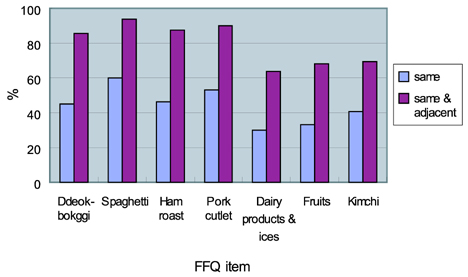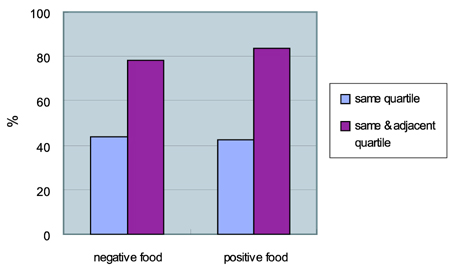Nutr Res Pract.
2007 Dec;1(4):313-320.
Comparison of major dish item and food group consumption between normal and obese Korean children: application to development of a brief food frequency questionnaire for obesity-related eating behaviors
- Affiliations
-
- 1Department of Food and Nutrition, Sungshin Women's University, Seoul 136-742, Korea. hsahn@sungshin.ac.kr
Abstract
- This study sought to compare intake levels of major dish items and food groups between normal and obese Korean children in order to understand obesity-related eating behaviors. The study was also conducted to apply the information on the differences in major dish items and food groups found in this study to development of a brief food frequency questionnaire (FFQ) for children's obesity-related eating behaviors. Finally, the developed FFQ was evaluated for reliability. A total of 290, 24-hour dietary recall data from 9-11 year-old normal or obese participants in the 2001 Korean National Health and Nutrition Examination Survey (KNHANES) were reviewed to identify dish items and food groups showing outstanding differences between the normal and obese groups. Based on the level of intake amount between the two groups, a total of 7 items, including ddeokbokggi, spaghetti, ham roast, pork cutlet, dairy products & ices, kimchi, and fruits, were selected to be included in the FFQ. The former 5 items were seen to be consumed more in the obese group, while the latter 2 items were so in the normal group. The questionnaire was formatted into a frequency response section of a seven-category option and reference period of the last 7 days. Test-retest reliability of the developed FFQ was examined by administering it to 153, 9-11 year-old children at a public elementary school in Seoul twice at a month interval. The level of reliability was found to be reasonably high. In conclusion, this study suggests that high consumption of several high-calorie dish items and low consumption of kimchi and fruits may be important eating behaviors in relation to obesity risk among 9-11 year-old children who need nutrition educators' attention. The current study also implies that a simple FFQ can be utilized to reliably assess 9-11 year-old children's diets.
Keyword
MeSH Terms
Figure
Reference
-
1. Buzzard IM, Stanton CA, Figueiredo M, Fries EA, Nicholson R, Hogan CJ, Danish SJ. Development and reproducibility of a brief food frequency questionnaire for assessing the fat, fiber, and fruit and vegetable intakes of rural adolescents. J Am Diet Assoc. 2001. 101:1438–1446.
Article2. Choi HJ, Seo JS. Nutrient intakes and obesity-related factors of obese children and the effect of nutrition education program. Korean Journal of Community Nutrition. 2003. 8:477–484.3. Cullen KW, Baranowski T, Baranowski J, Hebert D, Moor C. Pilot study of the validity and reliability of brief fruit juice and vegetable screeners among inner city African-American boys and 17 to 20 year old adults. J Am Coll Nutr. 1999. 18:442–450.
Article4. Field AE, Peterson KE, Gortmaker SL, Cheung L, Rockett H, Fox MK, Colditz GA. Reproducibility and validity of a food frequency questionnaire among fourth to seventh grade inner-city school children: implications of age and day-to-day variation in dietary intake. Public Health Nutr. 1999. 2:293–300.
Article5. Flegal KM. The obesity epidemic in children and adults: current evidence and research issues. Med Sci Sports Exerc. 1999. 31:S509–S514.
Article6. Flegal KM, Troiano RP. Changes in the distribution of body mass index of adults and children in the US population. Int J Obes Relat Metab Disord. 2000. 24:807–818.
Article7. Harnack LJ, Lytle LA, Galuska DA, Schmitz K, Jacobs DR, Gao S. Reliability and validity of a brief questionnaire to assess calcium intake of middle-school-aged children. J Am Diet Assoc. 2006. 106:1790–1795.
Article8. Heo YH, Choi MJ. A study on the weight control and food habit in obese and normal-weight elementary children. Journal of the East Asian Society of Dietary Life. 2006. 16:272–280.9. Jensen JK, Gustafson D, Boushey CJ, Auld G, Bock MA, Bruhn CM, Gabel K, Misner S, Novotny R, Peck L, Read M. Development of a food frequency questionnaire to estimate calcium intake of Asian, Hispanic, and white youth. J Am Diet Assoc. 2004. 104:762–769.
Article10. Kim HG, Nam HK. A survey of life style habits of obese school children. Journal of the Korean Society of School Health. 1998. 11:99–110.11. Kim HS, Kim HL, Hong SC. The prevalence and the factors associated with childhood and adolescent obesity in Jeju city. Journal of the Korean Society of Health Statistics. 2002. 27:66–80.12. Korea Ministry of Health and Welfare (KMHW). Korea Centers for Disease Control and Prevention (KCDC). 2005 Korea National Health and Nutrition Examination Survey-Health Examination Survey. 2006. Seoul. Republic of Korea:13. Kromeyer-Hauschild K, Zellner K, Jaeger U, Hoyer H. Prevalence of overweight and obesity among school children in Jena (Germany). Int J Obes Relat Metab Disord. 1999. 23:1143–1150.
Article14. Lee DH. A study on eating behavior, recognition of body image, weight control method, nutritional status, and blood parameters of obese children in Iksan city. Journal of the East Asian Society of Dietary Life. 2005. 15:663–674.15. Moreno LA, Sarria A, Fleta J, Rodríguez G, Bueno M. Trends in body mass index and overweight prevalence among children and adolescents in the region of Aragon (Spain) from 1985 to 1995. Int J Obes Relat Metab Disord. 2000. 24:925–931.
Article16. Ogden CL, Carroll MD, Curtin LR, McDowell MA, Tabak CJ, Flegal KM. Prevalence of overweight and obesity in the United States, 1999-2004. JAMA. 2006. 295:1549–1555.
Article17. Reilly JJ, Dorosty AR. Epidemic of obesity in UK children. Lancet. 1999. 354:1874–1875.
Article18. Rinderknecht K, Smith C. Body-image perceptions among urban Native American youth. Obes Res. 2002. 10:315–327.
Article19. Rockett HR, Wolf AM, Colditz GA. Development and reproducibility of a food frequency questionnaire to assess diets of older children and adolescents. J Am Diet Assoc. 1995. 95:336–340.
Article20. Vereecken CA, Maes L. A Belgian study on the reliability and relative validity of the Health Behavior in School-Aged Children food-frequency questionnaire. Public Health Nutr. 2003. 6:581–588.
Article21. Watson JF, Collins CE, Dibley MJ, Garg MG, Sibbritt D. Design considerations in the development of a food-frequency questionnaire for school-aged children. Asia Pac J Clin Nutr. 2003. 12:S24.22. World Health Organization (WHO). Obesity and overweight. 2006. Accessed on 2/23/2007. http://www.who.int/mediacentre/factsheets/fs311/en/index.html.23. Zhang M, Binns CW, Lee AH. A quantitative food frequency questionnaire for women in southeast China: development and reproducibility. Asia Pac J Public Health. 2005. 17:29–35.
Article
- Full Text Links
- Actions
-
Cited
- CITED
-
- Close
- Share
- Similar articles
-
- Measuring the status of obesity prevalence and food habit of children in Asan city
- Effect of Nutrition Education Program in Obese Children and Their Parents(II) : Focus on Nutrition Knowledge, Eating Behaviors, Food Habit and Nutrient Intakes
- A Retrospective Study on the Status of Obesity and Eating and Weight Control Behaviors of Elementary School Children in Inchon
- A Comparative Study of Obese Children and Normal Children on Dietary Intake and Environmental Factors at an Elementary School in Inchon
- Comparison of Dietary Behaviors and Blood Clinical Indices in Underweight, Normal Weight, Normal Weight Obese and Obese Female College Students



